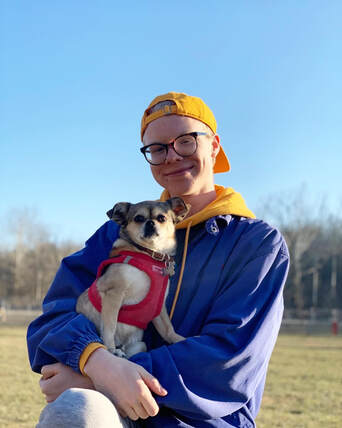 Hi! My name is Oliver Allen, but most people call me Mel. I’m a second year student studying Computer Science and Math with a minor in Art History, and I also play marimba when I’m not studying or writing programs. I started working at the Critical Food Studies Lab in January of 2019 doing basic statistics, but now I am focused on applying my skills in computer science and machine learning to analyze data surrounding food justice and sustainability. I started the semester by working with Lab Director Angela Babb to create a dataset of average food consumption and nutrient profiles to assist in analysis of the Thrifty Food Plan calculation. The Thrifty Food Plan is the basis of how the USDA allocates Supplemental Nutrition Assistance Program (SNAP) benefits to over 42 million people annually, but the latest released calculation was done with data from 2001, which is nearly 20 years old. In order to perform a relevant analysis of the Thrifty Food Plan calculation we needed an updated dataset of food consumption and relevant nutrient profiles for each of the foods in the USDA Dietary Guidelines for Americans. I had to approximate the dataset used by the USDA with something built from publically available data, so I ended up downloading all of the responses to the National Health and Nutrition Examination Survey (NHANES) for 2015-2016 and working with the data in R to separate it into each of the age-sex groups specified by the Thrifty Food Plan. Each row was a food group (for example provolone cheese, roast beef, Dippin’ Dots, etc.) and there were two columns representing national consumption data and then information on the food’s nutrient profiles. Eventually we had a dataset that could at least in part approximate the one used for the Thrifty Food Plan calculation and facilitate further analysis of the USDA’s model. In the latter half of the semester I worked to apply machine learning techniques to data about behavior surrounding switching to a sustainable diet. I used data from a survey given by the Sustainable Food Systems Science research group at IU to approximately 500 heads of households in Indiana, and I implemented a machine learning model to predict behavior around switching to a sustainable diet from demographic data. I also used this model to analyze which demographic features are most important when deciding whether a person will switch to a sustainable diet or not, or whether they will switch gradually over time versus switching quickly due to an event or crisis. I built additional models for each of these problems to further analyze the influence of each feature in the prediction, and I hope to continue looking into applications of machine learning with data around food security and sustainability to gain insight into why people make the choices they do surrounding food and diet.
34 Comments
9/5/2022 09:00:06 am
Really informative article, I had the opportunity to learn a lot, thank you. https://freecodezilla.net/superio-wp-theme/
Reply
9/11/2022 12:59:18 pm
Really informative article, I had the opportunity to learn a lot, thank you. https://kurma.website/
Reply
9/14/2022 03:03:17 pm
Really informative article, I had the opportunity to learn a lot, thank you. https://bit.ly/site-kurma
Reply
9/30/2022 08:07:34 am
It's great to have this type of content. Good luck with your spirit. Thank you. https://bit.ly/site-kurma
Reply
10/4/2022 09:02:17 pm
I think this post is useful for people. It has been very useful for me. Looking forward to the next one, thank you. https://escortnova.com/escort-ilanlari/konya-escort/hadim-escort/
Reply
10/5/2022 10:37:52 am
It was a post that I found very successful. Good luck to you. https://escortnova.com/escort-ilanlari/antalya-escort/kumluca-escort/
Reply
10/6/2022 01:00:42 am
I follow your posts closely. I can find it thanks to your reliable share. Thank you. https://escortnova.com/escort-ilanlari/eskisehir-escort/mihalgazi-escort/
Reply
10/6/2022 07:02:07 am
I support your continuation of your posts. I will be happy as new posts come. Thank you. https://escortnova.com/escort-ilanlari/mersin-escort/akdeniz-escort/
Reply
10/6/2022 11:09:32 pm
I think the content is at a successful level. It adds enough information. Thank you. https://escortnova.com/escort-ilanlari/bursa-escort/osmangazi-escort/
Reply
10/7/2022 08:56:26 pm
Thank you for your sharing. I must say that I am successful in your content. https://escortnova.com/escort-ilanlari/izmir-escort/konak-escort/
Reply
10/8/2022 10:24:22 am
Thoughtful and real content is shared. Thank you for these shares. https://escortnova.com/escort-ilanlari/kirsehir-escort/merkez-escort/
Reply
11/21/2022 08:52:29 am
Sitemizi ziyaret et ve evden is imkanina bak: https://sites.google.com/view/evden-ek-is/
Reply
12/9/2022 08:40:52 am
İnstagram beğeni satışı yapan firmamıza göz atın: https://takipcialdim.com/instagram-begeni-satin-al/
Reply
12/9/2022 08:41:30 am
Uygun fiyatlardan takipçi satın al: https://takipcialdim.com/
Reply
12/15/2022 08:14:44 am
takipçi satın al ve sitemizi ziyaret et: https://takipcim.com.tr/
Reply
12/19/2022 10:04:47 pm
İnstagram takipçi satın almak istiyorsan tıkla.
Reply
1/5/2023 05:16:06 am
100 tl deneme bonusu veren siteleri öğrenmek istiyorsan tıkla.
Reply
1/26/2023 11:34:35 pm
Informative content... Thanks for sharing
Reply
4/27/2023 07:14:43 pm
Steroid Sipariş: https://www.anabolickapinda14.com/urun/
Reply
8/9/2023 09:24:16 am
Steroid Siparis Steroid Fiyatlari Steroidler Anabolizan Orjinal Steroid Steroid Satis Steroid Satın Al Steroid Siparis Et
Reply
8/15/2023 06:36:32 am
https://www.sporunuyap8.com/ teşekkürler
Reply
Leave a Reply. |
AuthorSThis blog features the current work of CFS Lab researchers in their own words. Archives
October 2021
Categories |
 RSS Feed
RSS Feed
